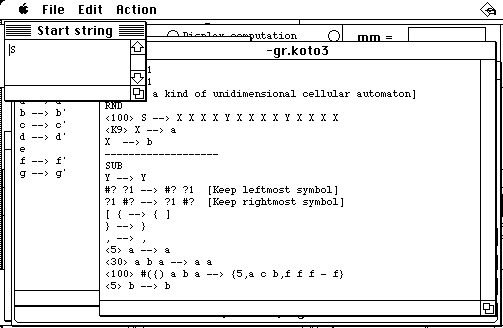Generally
the start strin
g
is predefined symbol 'S', but sometimes you may want to derive other strings of
variables/terminal symbols, especially while debugging a grammar. Type or
paste start strings on separate lines in the "Start string" window, then select
the one you want by highlighting it with the mouse. If you select no start
string then the first one in the window is always used. Since 'S' is already
there whenever you start the program you may ignore this "Start string" window
until you decide to use alternate start strings.
Another,
more intuitive, way of using any expression as a start strin
g
is to select it in any window (including the grammar itself) and type cmd-p or
select "Play selection" in the "Action" window. Normally this command tries to
interpret the selection (using the alphabet), but if the selection contains
variables then it is taken as a start string and the grammar is prompted to
derive a
single
item from it.
